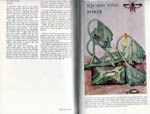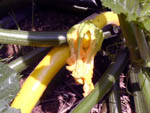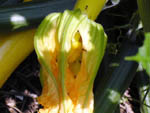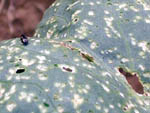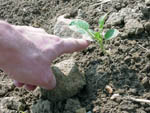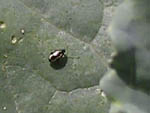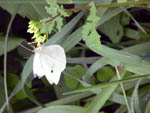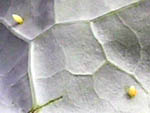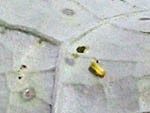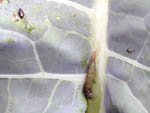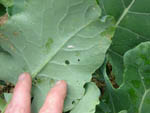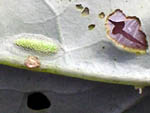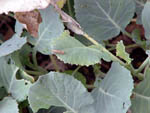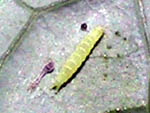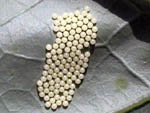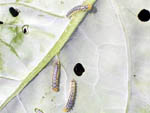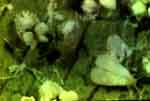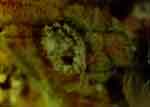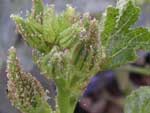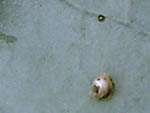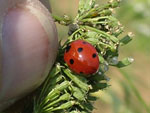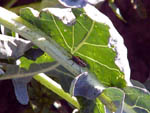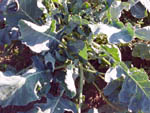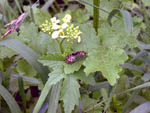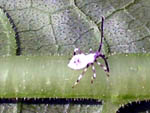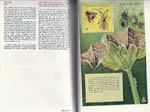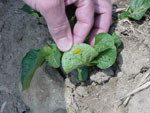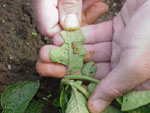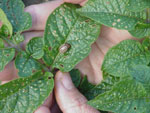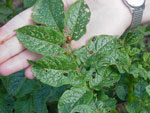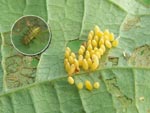Vegetable Pests
(of the Southeastern USA)
|
Order Lepidoptera:Squash Vine Borers
|
|
| Squash Vine Borers - Melittia curcurbitae/satyriniformis - Adults are blue/black stout bodied moths with clear wings; males have
a red velvet coating; larvae tunnel at the base of the stalks. Controls
- Gently split stalks and remove larva by hand - bury or tie split stalk
to heal. Remove infested material. Trap/watch for adults - Bt, or soap.
Tricks - Machata family squash (butternut) are more resistant to borers.
Or spray Bt twice weekly at base of plant during moth flight (Late June
- August). |
|
|
Order Coleoptera:Family Chrysomelidae:Flea Beetles (Phyllotreta spp. and others) |
|||
|
Leaf on Right: flea beetle holes make it unmarketable; Leaf on left Hb nemas - leaf is marketable; 3 weeks later in same plot. |
|||
| Flea beetles – different species
attack different plants (like eggplant vs. brassicas). Larvae live on the roots of the plants the adults are on. Controls – Nematode Heterhabiditis bacteriophora (Hb) attacks the larva – water them in under the plants being attacked – direct at the roots. Also, big-eyed bugs are supposed to eat flea beetle adults. Tricks – For nematodes, soil temperature must be above 55 degrees F. Critical to get healthy viable nematodes from a fresh, good source. Examine closely upon receipt. Can refrigerate good nemas for 2-4 weeks. You can apply nemas with a watering can or irrigate them in. BEST TIME IS AFTER A GOOD RAIN, BECAUSE Nemas MOVE ON A FILM OF WATER. |
|||
Broccoli Pests: Order Lepidoptera
|
Imported Cabbage Worm (ICW; Pieris rapae L.) |
|||
| ICW eggs are football shaped and yellow. | |||
|
Diamondback Moth (DBM; Plutella xylostella L.) |
|||
|
Cross-Striped Cabbageworm (XSCW- Evergestis rimosalis Guenee' |
|||
| Cabbage Caterpillars – Imported cabbageworm, diamondback moth, cross-striped cabbageworm, cabbage looper, cabbage webworm and a few more. Predators: ladybugs, syrphids, carabids, lacewings, soldier beetles, lightning bugs and predatory midges; and Parasitoids of worms – specific trichogramma and braconid wasps – cocoons are yellow or white. See Organic broccoli tab for more information on natural enemies. | |||
Whiteflies: Order Homoptera;
Family Aleyrodidae
Whiteflies - what species? Most common is Greenhouse whitefly (Trialeurodes vaporarum) wings held roof like over body); others include Silverleaf whitefly (Bemisia argentifolii) and Ash Whitefly (Pome Fruits). First Instar larvae are crawlers, and then become sessile nymphs. Sooty mold from honeydew. Controls: Parasites: Encarsia formosa for Greenhouse Whitefly; other Encarsia wasp species specific to each Whitefly (almost). Tricks – Encarsia can out reproduce the whiteflies by 2X if the temperature in the greenhouse is above 75 degrees Fahrenheit. Look for parasite’s “bullet like” exit hole (like in the movie Alien) vs. regular exit holes (T-shaped) on the pupa – determine % parasitization. Predators: Whitefly predator Delphastis pusillus, others include ladybugs, lacewings, and predatory bugs. There are also some whitefly fungal diseases available – Verticillium lecani.
Aphids - Order Homoptera
Family Aphidae
|
Aphids - dozens of species; some are specific to certain families of plants, and others are across species plant feeders. Anticipate aphids and release beneficials ahead of time to control aphids before they get a head start. Aphids (almost all are clones) are born pregnant! Aphids can reproduce at temperatures lower than most beneficials, so this is why aphids become a problem in the winter in greenhouses. Up the temperature for a good part of the day and your beneficials will out reproduce the pest. Controls - ladybugs, lacewings (work on Oleander aphids, which are poisonous), syrphid larva, Predatory midge (Ceciomyiidae) larvae (orange maggots), there are also several specific parasitic wasps- (Aphiidae & Aphelinidae). |
|||
Plant feeding Bugs; Order Hemiptera
Family Pentatomidae and others
|
Stink bugs/Harlequin bugs/ Squash Bugs - don't have continuous crucifers/ cleome. Controls: egg parasites, Trissolcus bassalis, T. murgantia, Ooencyrtus johnsoni, and several other parasitoids of adult bugs like the tachinid Trichopoda pennipes (see above under squash bug). Trap crops of mustards, radishes and cleome - remove/spray adults gathering on these plants |
||||
Colorado Potato Beetle; Order Coleoptera
Family Chrysomelidae
|
Colorado Potato Beetle (CPB) - Leptinotarsa decimlineata (10 lined beetle). The CPB is native to the western US, where it fed upon a solanaceous weed called buffalo burr. When the settlers introduced potatoes into its range, well, suffice it to say that CPB now gives Europeans and Russians a fit, too. Controls: a thick layer of mulch impedes beetle movement and pupation; no-till is a champion at this. Mulch also invites lots of ground beetles; Lebia spp. is specific to CPB. Farmscape to bring in egg predators like ladybeetles, bombadier beetles, lightning bugs, soldier beetles. These will all eat the eggs and small larvae of the CPB. Release healthy ladybugs from a reputable source if you need help. See ladybug release instructions under beneficials. |
|||
Spider Mites - nip these in the "bug". Spider
mites are Arachnids - webbing and small reddish mites (2-spots; mites are
the size of this dot(.) - leaves curl under. Check for mites with a loop.
Controls: predatory mites (expensive but good) - get a mix of 2 or 3 species
of predatory mites - different species work at different temperatures/humidities
- so a mix is best. Also ladybugs, lacewings, syrphid larvae and predatory
midge larvae will attack and control populations if done early enough. Rescue
treatments using hot pepper wax, insecticidal soap or similar approved organic
control.
Cucumber beetles - (Order Coleoptera; Family Chrysomelidae) several types Diabrotica - 3 spp.
- Western (adults dark green & have W on back), Southern (12-spotted Cuke
beetle), and Northern (adults are Solid Green) larvae (rootworms) are similar
in life history to flea beetle larvae. Supposedly, there is bait for these
- watermelon juice. Control: Trap adults; use Hb nematodes as under Flea beetles
above.
Japanese beetle Popillia japonica Newman (JB)/Exotic scarabs (oriental beetle, Exomala orientalis (OB)
Asiatic Garden Beetle, etc.) Order Coleoptera; Family Scarabaeidae).
JB & exotic scarab larva (grubs) live in the soil and feed on plant roots.
Controls - Nematode Heterorhabiditis bacteriophora (Hb). Parasites: 1) Tiphia
vernalis - wasp attacks JB/OB grubs in the soil (www.drmcbug.com); 2) Istocheta aldrichi - tachnid that attacks adult Jbs. Tricks -
nemas, soil temperature must be above 60 degrees F. Critical to get healthy
viable nematodes from a fresh, good source. Can refrigerate good nemas for
2-4 weeks. For Tiphia, Tulip poplar trees or a similar nearby nectar source
is necessary to get high rates of parasitization.
Mexican Bean Beetle and Squash Beetle - Control -Pediobius foevulatus - wasp; doesn't overwinter. Timing and release amount (1000 wasps total) is
critical! Release when you see EGGS of Beetles. Make two releases of wasps
about 2-3 weeks apart- so you are releasing wasps that will be present when
all the larvae of the bean beetle are created. Beetle larvae become mummified,
turn brown, and have exit holes where the wasps emerge. These things work
well in warm summers. May not work well in cool, wet summers…these
wasps are tropical, so put them out after all danger of frost is past. Umbels are good food plants.
